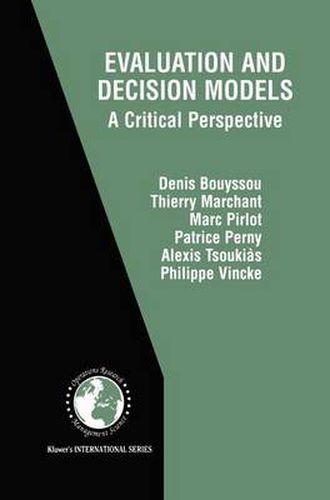Readings Newsletter
Become a Readings Member to make your shopping experience even easier.
Sign in or sign up for free!
You’re not far away from qualifying for FREE standard shipping within Australia
You’ve qualified for FREE standard shipping within Australia
The cart is loading…






This title is printed to order. This book may have been self-published. If so, we cannot guarantee the quality of the content. In the main most books will have gone through the editing process however some may not. We therefore suggest that you be aware of this before ordering this book. If in doubt check either the author or publisher’s details as we are unable to accept any returns unless they are faulty. Please contact us if you have any questions.
The purpose of this text is to provide a critical thinking framework for all individuals utilizing decision and evaluation models, whether it be for research or applications. It is axiomatic that all evaluation and decision models suffer some limitations. There are situations where a decision model will not perform to expectations. This book argues that there is no best decision or evaluation model, but that decision-makers must understand the principles of formal evaluation and decision models and apply them critically. Hence, the book seeks to deepen our understanding of evaluation and decision models and encourage users of these models to think more analytically about them. The authors work in six different European universities. Their backgrounds are varied: mathematics, economics, engineering, law, and geology, and they teach in engineering, business, mathematics, computer science, and psychology in their universities. As a group, the authors have particular expertise in a variety of decision models that include preference modelling, fuzzy logic, aggregation techniques, social choice theory, artificial intelligence, problem structuring, measurement theory, operations research, and multiple criteria decision support. In addition to their decision analysis research, all the authors have been involved in a variety of high-impact applications which include software evaluation, location of a nuclear repository, the rehabilitation of a sewer network, and the location of high-voltage lines. It is this variety within the authorship that unifies this book into a systematic examination of how best formal decision models can be used. The monograph should prove a useful tool for researchers of decision analysis and decision-makers.
$9.00 standard shipping within Australia
FREE standard shipping within Australia for orders over $100.00
Express & International shipping calculated at checkout
Stock availability can be subject to change without notice. We recommend calling the shop or contacting our online team to check availability of low stock items. Please see our Shopping Online page for more details.
This title is printed to order. This book may have been self-published. If so, we cannot guarantee the quality of the content. In the main most books will have gone through the editing process however some may not. We therefore suggest that you be aware of this before ordering this book. If in doubt check either the author or publisher’s details as we are unable to accept any returns unless they are faulty. Please contact us if you have any questions.
The purpose of this text is to provide a critical thinking framework for all individuals utilizing decision and evaluation models, whether it be for research or applications. It is axiomatic that all evaluation and decision models suffer some limitations. There are situations where a decision model will not perform to expectations. This book argues that there is no best decision or evaluation model, but that decision-makers must understand the principles of formal evaluation and decision models and apply them critically. Hence, the book seeks to deepen our understanding of evaluation and decision models and encourage users of these models to think more analytically about them. The authors work in six different European universities. Their backgrounds are varied: mathematics, economics, engineering, law, and geology, and they teach in engineering, business, mathematics, computer science, and psychology in their universities. As a group, the authors have particular expertise in a variety of decision models that include preference modelling, fuzzy logic, aggregation techniques, social choice theory, artificial intelligence, problem structuring, measurement theory, operations research, and multiple criteria decision support. In addition to their decision analysis research, all the authors have been involved in a variety of high-impact applications which include software evaluation, location of a nuclear repository, the rehabilitation of a sewer network, and the location of high-voltage lines. It is this variety within the authorship that unifies this book into a systematic examination of how best formal decision models can be used. The monograph should prove a useful tool for researchers of decision analysis and decision-makers.